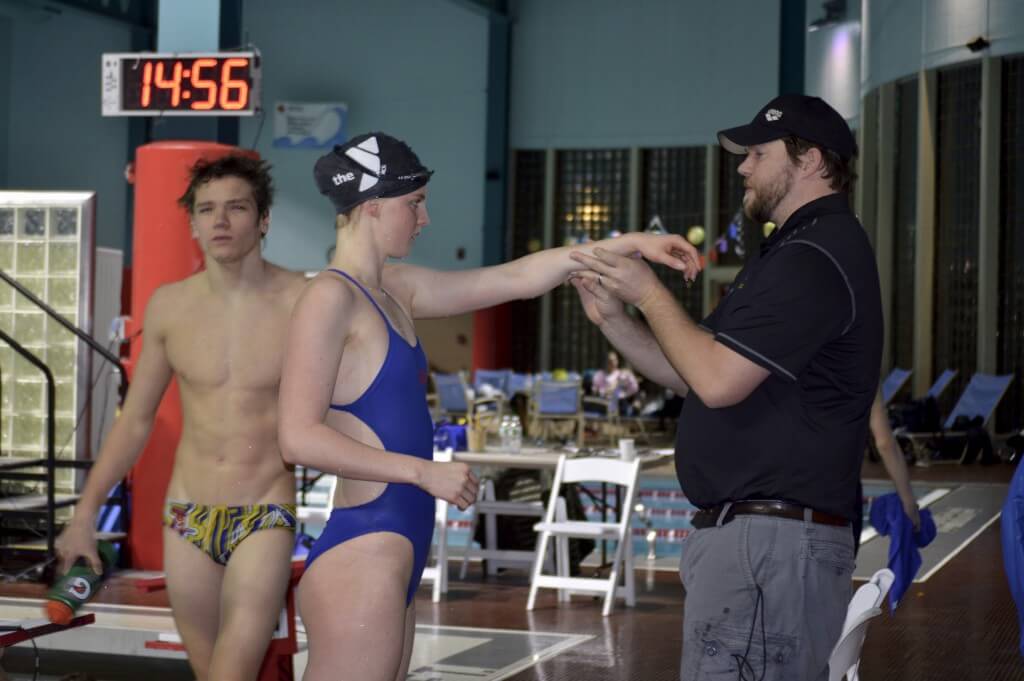Swimmer’s Shoulder: The Most Common Injury to a Swimmer’s Engine

Swimmer’s Shoulder: The Most Common Injury to a Swimmer’s Engine
By Vanessa Steigauf, Swimming World College Intern
If you see someone constantly rubbing and stretching their shoulders, you very likely encountered a swimmer. (The damaged hair and rumpled sweatpants will give you additional hints). From mild pinching to intense pain, swimmers’ shoulders never fail to remind us how hard today’s practice was. But why are swimmers so prone to developing shoulder injuries? And why does it seem like some swimmers can swim forever without any issues while others have to be careful with every stroke they take to not stress their shoulders too much?
Why Does It Have to Be Us Swimmers?
As swimmers, we perform an unnaturally high amount of overhead movements that require a lot of strength. We are, therefore, more susceptible than average individuals to develop shoulder injuries. During a stroke, our shoulders do most of the work to propel our bodies forward against the resistance of water. And with around 4,000 strokes per practice, it makes sense that our shoulders might be worn out faster than other joints like our hips or knees.
The constant dilemma for our shoulders is between flexibility and stability. The shoulder joint is the one with the greatest range of motion of all joints in our body. To ensure a healthy joint with such great flexibility, we need a lot of stabilizing factors. Therefore, several ligaments are holding the bones around our shoulder joint together and still leave a lot of freedom for movement. This whole construction usually works out fine – if we don’t do an excessive amount of overhead movements, which bring our shoulders into a position where ligaments and muscles can easily be pinched between two bones.

Photo Courtesy:
In swimming, we have such overhead movements all the time. In most strokes, we reach above our heads to pull ourselves forward against the water. This motion pushes ligaments and muscles that anchor our humerus bone to surrounding structures of the shoulder against the acromion, another bone on top of our shoulder blade. Repeated overhead motions and, therefore, repeated pinching of the tissues can lead to irritation of the rotator cuff tendon and the subacromial bursa, a soft sac just below the acromion. This leads to the painful pinching we can sometimes feel after swimming, called the shoulder impingement syndrome.
Factors Contributing to Shoulder Injuries
While some individual (intrinsic) factors like joint laxity can increase the risk for shoulder impingement syndrome, there are many extrinsic factors that usually cause shoulder pain. Extreme intensity (overuse) or a wrong technique (misuse) are such factors. During overuse, the muscles don’t get enough rest to fully recover. Fatigued muscles of the shoulder are more prone to be pinched between bones and cause pain faster. A wrong technique can also lead to unhealthy movements in our shoulder joints that cause the painful pinching.
The good news is that we are in control of all the extrinsic factors causing shoulder injuries. When we realize our shoulder is starting to feel off, we should act right away and get rid of any mild pinching before it turns into a chronic swimmer’s shoulder injury.
To reduce shoulder pain, swimmers can:
- Temporarily reduce training volume and intensity.
- Include different strokes into the practice routine to have a wide variety of shoulder movements.
- Avoid the use of paddles.
- Use fins more often to have the legs propel the body forward rather than the shoulders.
If the shoulder pain does not go away, the only thing that will really help is to take a break from swimming. But obviously, this is not a sentence any swimmer likes to hear.
To prevent shoulder injuries from occurring in the first place, there are several measures we can take to strengthen and prepare our shoulders for the many rough yards they have to pull us through during practice. A proper technique is certainly one of them.
Proper Technique Helps Prevent Shoulder Injuries
For long axis strokes like freestyle and backstroke, it is important to keep the hand in front of the shoulder during your water entry. As soon as the hand reaches farther than the midline, this is a movement that can cause impingement in your shoulders. Strong abs and legs also help prevent swimmer’s shoulder. While at first it doesn’t seem like a strong core could help prevent shoulder injury, it actually plays a big role. Hip rotation reduces the pressure that is on our shoulders during the pull. So does kicking. Generating more power that pushes you through the water reduces the amount of stress on anything you use to pull yourself forward. As rotation is only possible in freestyle and backstroke, you should focus even more on your kick in fly and breaststroke to support your shoulders in their movements.
Finally, a key to reducing your risk for shoulder injury is a proper warmup. Before every practice you should take some extra minutes to warm up your shoulders. Getting used to the many overhead movements is important to decrease the friction between soft tissues and the bones in your shoulder.
Of course, these factors can’t eliminate the risk of getting your shoulder injured. But they can give you a good starting point to try to get rid of injuries or prevent them in the first place.
All commentaries are the opinion of the author and do not necessarily reflect the views of Swimming World Magazine nor its staff.



